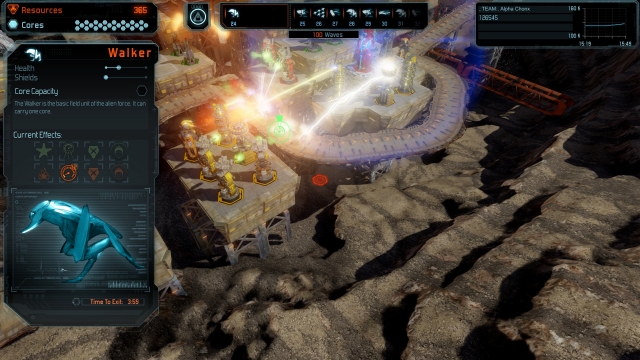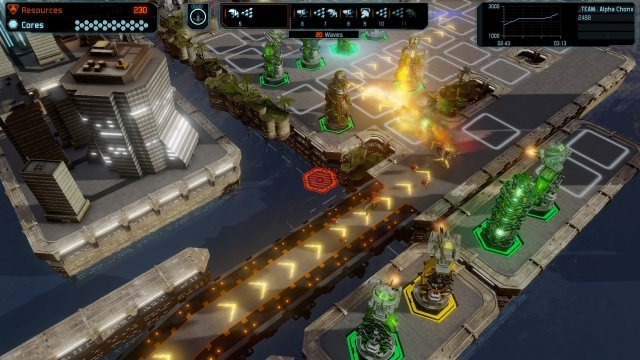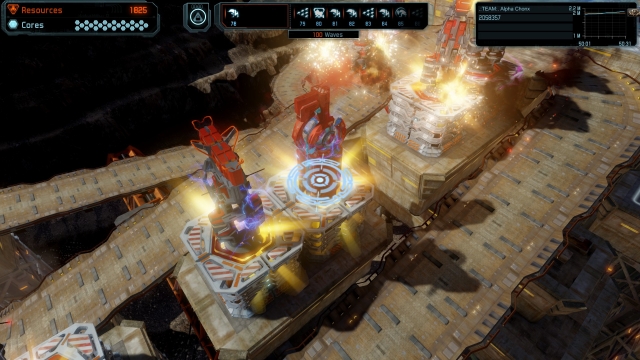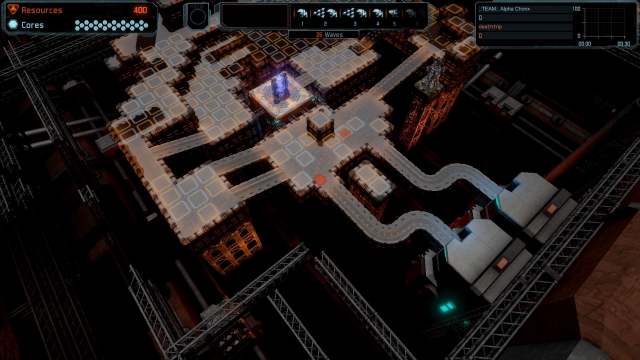
Defense Grid 2 Review
Defense Grid: The Awakening drastically raised the bar for the tower defense genre in late 2008 when it was originally released for Windows PC. Combining exceptional production values (especially for an indie game) and really excellent game design, balance and replayability, DG: The Awakening set the standard for all tower defense games which have come after it and subsequently solidified its success with a release on Xbox 360 in late 2009.

Defense Grid 2 returns us in style to the world of floating cores, racers and level three temporal towers but how does it measure up to its predecessor? Is DG once again launching the genre to new and unexpected heights? To answer that question, I’ll start with the basics.
For those who aren’t familiar with the games, Defense Grid 2 follows the first game’s formula very closely. You play the role of ‘the commander’ who is tasked with working together with a very eccentric AI named Fletcher to prevent alien invaders from stealing ‘cores’ which are being used as a power source for human activities, the AI, and the defense grid itself.
Each level presents the player with a central housing filled with cores, a route the aliens will follow to get to the cores and a grid of points where towers may be built. There are ten tower types to choose from and each can be upgraded to level three for maximum effectiveness. New to the franchise are boost towers which allow towers built on top of them to gain various minor enhancements, such as an overcharge for more damage or a score boost for aliens killed in the immediate vicinity. All of the old favorites have returned from the first game with the exception of command towers. Another noticeable change is that missile towers will now target any aliens as opposed to their exclusively anti-air role in the previous title. In fact, flying aliens are missing altogether which strikes me as a somewhat odd move on the part of Hidden Path, as there was a definite opportunity there to expand on them in this game and add another strategic consideration for players. An opportunity missed in my opinion, although hopefully, we may still see them pop up in the inevitable future DLC.

Building and upgrading towers is achieved by spending resources. Resources are gained slowly over time but having more unspent resources will cause you gain them faster. This means that holding off that upgrade for a few seconds to let your resources pile up can be a vital tactical decision. Resources are also awarded as you kill aliens and at the end of each wave.
The aliens will always follow the quickest available path to the cores and will try and make off with them once they have them. The depth of the strategy in DG:2 comes equally from clever tower placement to extend the alien’s route to and from the cores and choosing which towers to build where and when.
Visually, Defense Grid 2 is far superior to the first title, boasting a much higher level of detail on the stages, the towers themselves and the alien invaders. The animations for the towers are particularly high quality; zooming right in and seeing all the reloading mechanisms at work inside the towers is especially satisfying. Even with a level full of towers and aliens and all their associated particle effects, the spectacle doesn’t cause a dent in the frame rate, which is testament to the efficiency of the new game engine. The game’s score and sound effects all work well. The music will rise and fall in intensity with the on-screen action and provides ambience and liveliness in equal measure. The effects for the towers firing and aliens dying haven’t changed a great deal from those found in the first game but they serve their purpose adequately.

Defense Grid 2’s story is fairly interesting and ties in nicely with the first game’s but can be ignored or turned off completely without drastically affecting the enjoyment of the game. This time around there are multiple AIs on hand to help and each comes with their own special ability. Unfortunately, one area in which the quality doesn’t quite match the rest of the game is the voice acting and the dialogue itself. It’s a little bit hit and miss and sometimes comes across as just plain cringeworthy. After my first playthrough I found myself in the audio options menu looking for a way to turn it off, and haven’t felt the need to turn it back on since.
Fans of Defense Grid: The Awakening should be glad to know that most of the 21 levels in the campaign can be replayed with a host of game modes both old and new. Grinder mode makes a welcome return alongside new modes such as focal point, which lets the mouse cursor do damage to aliens. Each can be played across four difficulty settings ranging from easy to elite. For the purposes of this review I played through the entire single-player campaign on normal which didn’t present much of a challenge. There were only two levels I didn’t finish on the first attempt, so I’d recommend veterans of the franchise jump straight into hard or elite for a more demanding and ultimately more satisfying experience.
At first, I was a little wary of the online multiplayer modes as I couldn’t think of how it could have been implemented in a fun and worthwhile way. I was a little worried that it was added merely as filler or just because not supporting online multiplayer is widely considered a bad move these days. Thankfully I was dead wrong on that one! There are three multiplayer modes. DG Fighter pits you against another player whose map will spawn all the aliens you kill and vice versa. Co-op Doubles sees two players working together to defend against the alien horde and sharing resources and map space. Finally, DG Coordinated Defense is similar to normal co-op but each player has their own resource pool and can only build towers on their own coloured tiles. This last mode is, for me, the most enjoyable by far and really encourages team-work and communication.

So does Defense Grid 2 make as much of an impact on the tower defense genre as Defense Grid: The Awakening?
Not really, but that’s not necessarily a bad thing. The formula hasn’t been changed much but it has been refined and improved upon in almost every way. The new engine makes everything look much, much nicer (Anti-aliasing support was added in the latest patch too) and the addition of online and local multiplayer means DG2 is a must for fans. Throw in a level editor on top of all that and that Defense Grid 2 is definitely worthy of your time and money.
While not being as much of a leap forward for the tower defense genre as the first game, Defense Grid 2 oozes quality and will provide both DG veterans and newcomers alike with hours and hours of enjoyment.
Defense Grid 2 (Reviewed on Windows)
This game is great, with minimal or no negatives.
While not being as much of a leap forward for the tower defense genre as the first game, Defense Grid 2 oozes quality and will provide both DG veterans and newcomers alike with hours and hours of enjoyment.












COMMENTS